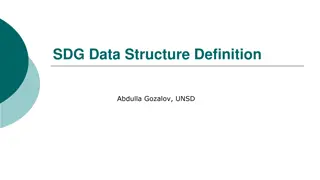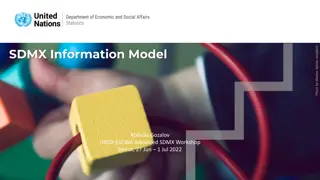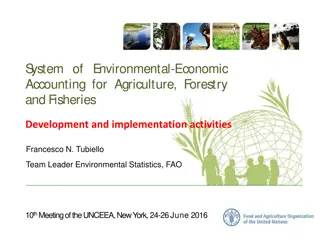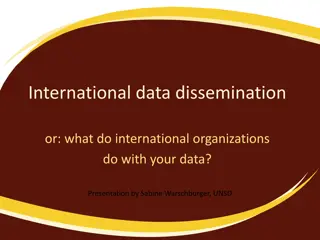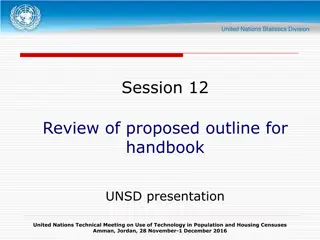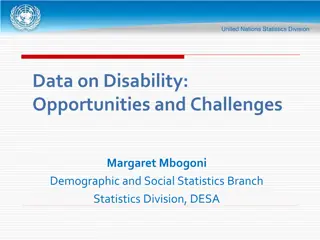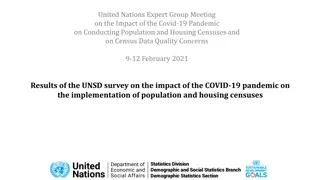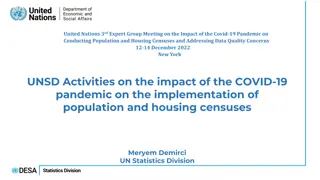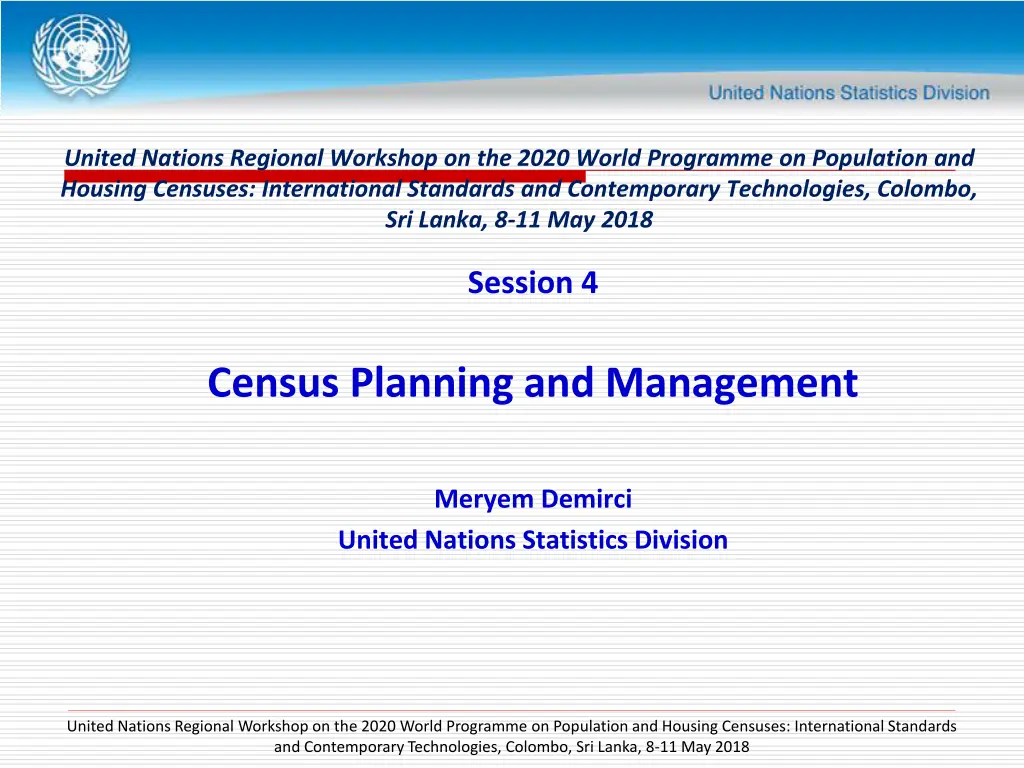
Census Planning and Management: Key Considerations and Strategies
Explore the essential aspects of census planning and management, including the importance of phase dependencies, dynamic planning, and effective resource allocation. Learn about key considerations for developing census plans, such as identifying stakeholders, setting strategic objectives, and monitoring progress. Discover how to ensure the success of each phase in the census cycle by maintaining flexibility and adapting to changing circumstances.
Download Presentation

Please find below an Image/Link to download the presentation.
The content on the website is provided AS IS for your information and personal use only. It may not be sold, licensed, or shared on other websites without obtaining consent from the author. If you encounter any issues during the download, it is possible that the publisher has removed the file from their server.
You are allowed to download the files provided on this website for personal or commercial use, subject to the condition that they are used lawfully. All files are the property of their respective owners.
The content on the website is provided AS IS for your information and personal use only. It may not be sold, licensed, or shared on other websites without obtaining consent from the author.
E N D
Presentation Transcript
United Nations Regional Workshop on the 2020 World Programme on Population and Housing Censuses: International Standards and Contemporary Technologies, Colombo, Sri Lanka, 8-11 May 2018 Session 4 Census Planning and Management Meryem Demirci United Nations Statistics Division United Nations Regional Workshop on the 2020 World Programme on Population and Housing Censuses: International Standards and Contemporary Technologies, Colombo, Sri Lanka, 8-11 May 2018
Census planning Planning can be regarded as the core of the census phases and the processes that is most critical to the completion of a successful census. (HM 2.2) United Nations Regional Workshop on the 2020 World Programme on Population and Housing Censuses: International Standards and Contemporary Technologies, Colombo, Sri Lanka, 8-11 May 2018
Links among census phases Due to the size and complexity of the census, it is usually organized into a set of dependent, related projects/phases Each phase of the census cycle is dependent on a preceding phase, with the quality of the output from each phase having a direct effect on the success of the next phase United Nations Regional Workshop on the 2020 World Programme on Population and Housing Censuses: International Standards and Contemporary Technologies, Colombo, Sri Lanka, 8-11 May 2018
Aim of census planning Identify all census phases and dependencies between the different phases - for effective management of overall census operation Ensure each phase is properly resourced and organized Due to the long duration of the census cycle, planning should not remain static but be dynamic and flexible to take into account changes that occur Plans must be regularly monitored, evaluated and updated reflecting changes in resource, timing of activities, quality control concerns and other un-anticipated events United Nations Regional Workshop on the 2020 World Programme on Population and Housing Censuses: International Standards and Contemporary Technologies, Colombo, Sri Lanka, 8-11 May 2018
Key considerations for developing census plans Role of the census Role of the government Identification of stakeholders and communication Strategic objectives for census Project management principles Monitoring Census calendar (scheduling) Administrative organization and human resources management Financial management (budgeting) Contracting out Use of technology Plans for census phases Documentation United Nations Regional Workshop on the 2020 World Programme on Population and Housing Censuses: International Standards and Contemporary Technologies, Colombo, Sri Lanka, 8-11 May 2018
Role of the census For planning purposes, the census should be considered as part of the National Statistical Programme Key strength of a census is to provide data for small geographic areas and for small population groups allowing disaggregation by a number of variables when data are not required at this level of detail, other statistical sources/ methodologies more cost-effective than censuses should be adopted United Nations Regional Workshop on the 2020 World Programme on Population and Housing Censuses: International Standards and Contemporary Technologies, Colombo, Sri Lanka, 8-11 May 2018
Role of the government Legal framework The authority of the census agency to undertake census activities The roles of other organizations (especially other government ministries and national mapping agencies) in census taking Obligations and rights of individuals to provide information, and that of enumerators and supervisors Provisions about confidentiality of information supplied by individuals The basis of enumeration, scope, method and timing of the census Funding of census operation Logistical support United Nations Regional Workshop on the 2020 World Programme on Population and Housing Censuses: International Standards and Contemporary Technologies, Colombo, Sri Lanka, 8-11 May 2018
Identification of stakeholders and communication Stakeholders within the census programme o Each phase is a key stakeholder of the one preceding it o Identifying internal stakeholders including other national organizations is useful for identifying dependencies, developing effective communication with these stakeholders Other stakeholders within the statistical agency o Regional offices supporting field operations, internal stakeholders using census results (eg. survey sample frames), units of NSO working on methodology, IT, public relations External stakeholders o Current and potential users of census data Stakeholders outside the country o Donors and international agencies who see census as central for evidence-based decision making funding, equipment, technical assistance Users, the public/community having interest at time of census/initial data release o Publicity campaigns on benefits of census, participation, addressing concerns on privacy and confidentiality United Nations Regional Workshop on the 2020 World Programme on Population and Housing Censuses: International Standards and Contemporary Technologies, Colombo, Sri Lanka, 8-11 May 2018
Strategic objectives for census Census plans are usually guided by a set of strategic objectives, which set standards and benchmarks against which outcomes can be assessed Strategic objectives are usually derived under the headings of: o Census content - ensuring that the topics are appropriate for users; o Impact on the public and on census staff operations and results are acceptable to the public and comply with legal and ethical standards. The public and census staff should be informed for their rights and responsibilities-confidentiality; o Production of census results - quality standards, timetable for census results; o Cost effectiveness- carrying out census as inexpensively as possible without compromising other strategic objectives; o Cost-benefit - increasing value or benefit generated from census. Objectives interact with one another, so priorities need to be set as there could be trade-offs, e.g., what topics to collect and costs United Nations Regional Workshop on the 2020 World Programme on Population and Housing Censuses: International Standards and Contemporary Technologies, Colombo, Sri Lanka, 8-11 May 2018
Project management principles Once the strategic objectives of a census have been established, more detailed planning can begin Given the size and complexity of the census, it can be divided into a series of related projects that are dependent on one another Principles of project management provide a simple hierarchical framework (consisting of phases, activities and tasks) for achieving an appropriate design of the census project o an iterative process and takes a number of iterations before achieving an appropriate design As the levels in the framework are filled with detail, people can be assigned responsibility, and reporting and review arrangements established United Nations Regional Workshop on the 2020 World Programme on Population and Housing Censuses: International Standards and Contemporary Technologies, Colombo, Sri Lanka, 8-11 May 2018
Hierarchical framework for design of census project Project: Population and housing census Phases: identifying and scheduling the various phases of the census cycle; phases are typically sequential; however, they occasionally can overlap Activities: once phases have been identified, the next step is to break down each phase into component activities; activities constitute a higher level of work covering the series of tasks defined for each phase Tasks: activities can further be broken down to tasks - the smallest identifiable amount of work leading to a deliverable under each activity; time, cost and resources can be assigned at the task level United Nations Regional Workshop on the 2020 World Programme on Population and Housing Censuses: International Standards and Contemporary Technologies, Colombo, Sri Lanka, 8-11 May 2018
Issues that need to be taken into account in project planning Milestones represents specific points along census project time at which key outcomes are expected and which measure a project s progress o Focusing on major progress points that must be reached to achieve success- such as determining method of enumeration, finalizing the questionnaire, finishing the enumeration, dissemination of final results, etc. Risk management - identification and assessment of risks followed by the development of actions aimed at mitigating the impact of undesired outcomes or reducing the probability of those outcomes happening o Potential risks should be identified in the planning phase for developing actions on time United Nations Regional Workshop on the 2020 World Programme on Population and Housing Censuses: International Standards and Contemporary Technologies, Colombo, Sri Lanka, 8-11 May 2018
Risk management Risks with significant likelihood should be managed by developing fully detailed plans to mitigate the consequences of these events and to set up alternatives Success or failure of the census may depend on the implementation of the plans associated with potential risks Implementing risk management in censuses: o Fosters early identification of strategies to reduce or eliminate the potential impact of known risks; o Provides a structure for monitoring and documenting changes in risk assessment and for managing the response to those changes; o Identifies areas where further study or analysis could potentially lower future risk; o Facilitates integration of operations/systems through early identification and resolution of risk that cuts across activities United Nations Regional Workshop on the 2020 World Programme on Population and Housing Censuses: International Standards and Contemporary Technologies, Colombo, Sri Lanka, 8-11 May 2018
Monitoring project plan It is important that project plans are monitored and that appropriate feedback is delivered periodically to all levels of management The most important components to track are: o the calendar time for completing a task; o resource usage per task; o cost per task; o milestones met As there are always interdependency among individual tasks, monitoring instruments are needed (eg. the GANTT chart which graphically displays activities, linkages between activities, date of starting/completing, milestones, delays, etc.) United Nations Regional Workshop on the 2020 World Programme on Population and Housing Censuses: International Standards and Contemporary Technologies, Colombo, Sri Lanka, 8-11 May 2018
Census calendar (scheduling) Development of a census calendar is a crucial step in the planning phase of a census, which serves as a guide to measure the progress of each stage of the census operation o designed to show the census activities and the amount of time required for undertaking all processes regarding the planning, development and implementation of a census o shows the sequence, interdependency and timing of all the various steps in the census programme (eg. GANTT chart) Time estimation of each activity is a critical process for good management of census operations - time estimation has to be undertaken in close cooperation with all stakeholders United Nations Regional Workshop on the 2020 World Programme on Population and Housing Censuses: International Standards and Contemporary Technologies, Colombo, Sri Lanka, 8-11 May 2018
Administrative organization and human resources management Establishing the administrative organization and staffing of a census operation is a big challenge due to the size and complexity of the project, geographic spread, long project timeline, coordination with a wide range of organizations, and the number of workers involved o census plans need to articulate the roles and responsibilities of the hierarchy of census staff The development phases (planning and preparations) and the operational phases might require different management approaches because the nature of the workforces and the tasks performed are quite different United Nations Regional Workshop on the 2020 World Programme on Population and Housing Censuses: International Standards and Contemporary Technologies, Colombo, Sri Lanka, 8-11 May 2018
United Nations Regional Workshop on the 2020 World Programme on Population and Housing Censuses: International Standards and Contemporary Technologies, Colombo, Sri Lanka, 8-11 May 2018
Structure of the workforce The staffing and structure of the workforce to support the enumeration phase should be decided based on the following factors : o Size of the population; Geographic area covered by the census o Existing administrative structure, at centre and in regions o Support from other government agencies o Activities contracted out o Data collection and processing methods used For a hierarchical workforce structure, there are a number of key issues that need to be addressed including: o Roles and responsibilities of each level (regional managers, supervisors, enumerators, IT officers, etc) o Time available; o Staffing ratio between the different levels. United Nations Regional Workshop on the 2020 World Programme on Population and Housing Censuses: International Standards and Contemporary Technologies, Colombo, Sri Lanka, 8-11 May 2018
Human resources management Management of human resources for census operations is of particular importance in the planning phase of the census o Growing interest for using new technologies is a very important factor for careful planning of human resources requiring special considerations to certain specialized skills such as mapping/GIS, data capture and processing, dissemination outputs/tools using new technologies Plans for human resources management require a two-pronged strategy: o Strategies for office work o Strategies for field work (plans for staff who employed temporarily) United Nations Regional Workshop on the 2020 World Programme on Population and Housing Censuses: International Standards and Contemporary Technologies, Colombo, Sri Lanka, 8-11 May 2018
Human resources management Strategies for human resource for the office work should be developed by taking into account: o maximizing the capacity of the existing staff; o needs for recruitment of new staff; o needs for new skills on permanent or temporary basis; o tools for developing capacity (in house training, study visits, consultation services during planning and implementation stages for certain activities) For the category of temporary field staff, careful consideration is needed in terms of: o the qualifications needed for census work o languages skills of enumerators and supervisors for area in which they will be working o the need for special training programme in some areas for gaining specific skills, such as use of tablet computers, or cultural and gender sensitivity. o early arrangements for developing training programme is necessary to use appropriate training facilities and produce training manuals United Nations Regional Workshop on the 2020 World Programme on Population and Housing Censuses: International Standards and Contemporary Technologies, Colombo, Sri Lanka, 8-11 May 2018
Financial management (budgeting) Census budget must be planned well in advance and cover all known activities, with sufficient resources allocated to each phase The budgeting process begins with drafting a list of activities and tasks to account for the financial cost of all census activities, Monitoring the census budget is critical regularly (quarterly or even monthly) monitor expenditures against funding for each project Estimates of expenditures for all years of the census cycle should be prepared in advance and reviewed yearly usually peaks during enumeration United Nations Regional Workshop on the 2020 World Programme on Population and Housing Censuses: International Standards and Contemporary Technologies, Colombo, Sri Lanka, 8-11 May 2018
Contracting out Many national statistical offices may need to contract out some of the tasks during a census operation in the interest of efficiency and lack of in house expertise Outsourcing decisions should be made within the context of a larger organizational plan that identifies choices between both hiring and training staff or using external service providers to augment or replace resources for specific projects Contracting out activities does not relieve census managers of their responsibility - so managers have to work closely with contractors and monitor them regularly United Nations Regional Workshop on the 2020 World Programme on Population and Housing Censuses: International Standards and Contemporary Technologies, Colombo, Sri Lanka, 8-11 May 2018
Contracting out The following should be considered while contracting out any activity: o Core census activities (eg. content of questionnaire, field enumeration) should not be contracted out o Evaluation of the risk of contracting out should be carried out o Clear understanding of the requirements and development of detailed technical specifications o Competitive bidding should be invited for contracted activities and demonstrations of capacity and good project management skills should be verified before outsourcing o Confidentiality and security of census data collected should not be compromised o Quality assurance guidelines for product/service should be laid out o Monitoring of outsourced activity for timeliness and quality of the delivery Careful control is needed to ensure that the selected external provider delivers a cost effective solution that meets the census agency s needs United Nations Regional Workshop on the 2020 World Programme on Population and Housing Censuses: International Standards and Contemporary Technologies, Colombo, Sri Lanka, 8-11 May 2018
Use of technology Growing interest for using new technologies (timeliness and quality of data, efficient operation control, better capacity for monitoring, etc) is a very important factor for census planning As the new technologies adopted may relate to only one part of the census operations, planners have to take account how it will impact or affect other operations The use of electronic data collection technologies requires early decision for redesigning and testing census phases/activities Adoption of multi-mode data collection requires careful consideration of issues including duplication, data comparability issues, timelines for each mode, and response integration United Nations Regional Workshop on the 2020 World Programme on Population and Housing Censuses: International Standards and Contemporary Technologies, Colombo, Sri Lanka, 8-11 May 2018
Use of electronic data collection - Key factors affecting decision Social, cultural, environmental factors . Public trust . Level of education . Transportation availability . Availability of electricity . Availability of broadband connectivity . Diversity - such as socio-economic, geographic, etc. . Response rate Technological factors ICT infrastructure . Internet accessibility (both nationally and at the individual household level) . Use of social media . Cellular/mobile phone coverage .. Institutional factors Economic factors .Experience in change management . High level and senior managerial support . Government commitment and support . Technical skills and capacity . Previous experience in electronic data collection . Stakeholder support . Appropriate legislative framework . Pressure for cost reduction of census operation . Resource mobilisation . Support from Government and other stakeholders for resource allocation Operational factors . Time required for - redesigning - capacity building - establishing IT infrastructure - procurement . Hardware requirements . Human resource needed . Assessment of costs, benefits, risks . Plans for reuse Decision on use of electronic data collection United Nations Regional Workshop on the 2020 World Programme on Population and Housing Censuses: International Standards and Contemporary Technologies, Colombo, Sri Lanka, 8-11 May 2018
Comparison of total costs for possible alternatives for data collection United Nations Regional Workshop on the 2020 World Programme on Population and Housing Censuses: International Standards and Contemporary Technologies, Colombo, Sri Lanka, 8-11 May 2018
Plans for census phases Topic selection: plans for user consultation, strategies for communication with users Questionnaire design and testing: plans for the use of long/short form, designing questionnaire format based on the technology used for collection, plans for testing, etc Mapping : Plans for producing/updating maps, strategies for partnering with mapping agency; plans for use of digital maps for field enumeration and dissemination, etc. Quality assurance: Plans for quality assurance procedures and quality teams Publicity and communication with public-strategies for special population groups Procurement and outsourcing-steps, procedures , evaluation of output/service quality Field enumeration: Plans for data collection mode(s), population difficult to enumerate; strategies for improving coverage; plans for monitoring; plans for logistics of census materials, etc. Data processing: plans for method of data capture, coding, editing/imputations, validation of census data, etc. Dissemination: plans for dissemination online tools/products, dissemination of disaggregated census results, monitoring SDG and national priorities Evaluation: plans for method(s) of evaluation of the quality of census data United Nations Regional Workshop on the 2020 World Programme on Population and Housing Censuses: International Standards and Contemporary Technologies, Colombo, Sri Lanka, 8-11 May 2018
Documentation Census organizations need to pay special attention to continuity of knowledge and skills from one census to the next, since the intervening gap, which is usually a whole decade, is likely to cause loss of institutional memory and attrition of qualified personnel (P&R 2.94) Comprehensive documentation of census activities while they are being carried out is essential, as is training of younger personnel to create a pool of knowledgeable and experienced persons by the time the next census comes (P&R 2.94) Evaluation and recording should not be left until the end of the census process and early census planning needs to take this into account Administrative report - a report where all census experiences are recorded can help retain census historical memory and serve as a resource for transferring knowledge United Nations Regional Workshop on the 2020 World Programme on Population and Housing Censuses: International Standards and Contemporary Technologies, Colombo, Sri Lanka, 8-11 May 2018
Reference materials for this presentation Handbook on the Management of Population and Housing Censuses, Revision 2 Principles and Recommendations for Population and Housing Censuses, Revision 3 Guidelines on the Use of Electronic Data Collection Technologies in Censuses United Nations Regional Workshop on the 2020 World Programme on Population and Housing Censuses: International Standards and Contemporary Technologies, Colombo, Sri Lanka, 8-11 May 2018

